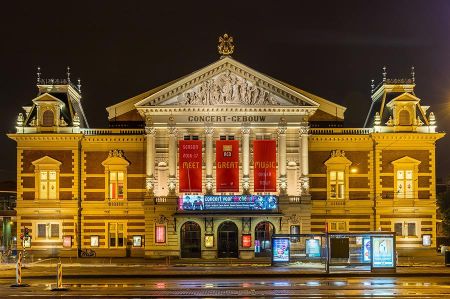Van Gogh Museum and the Concert-Gebouw
- Written by Portal Editor
If you, like us, actually want to visit the Van Gogh Museum, you should think about the exact date well in advance and book accordingly, because the Van Gogh Museum is one of the most visited museums in the Netherlands, and probably even in the world.
When you book you get a time slot, which you have to stick to, otherwise you have no chance. A spontaneous attempt is almost hopeless. Having said that, it doesn't lead to major disappointments. However, the building complex itself also has a lot to offer, including a large collection of literature on art and art history by a wide variety of artists, so we spent a few hours of interesting research here, especially on the graphic artist MC Escher.
Old building by Gerrit Rietfeld – new by Kishō Kurokawa
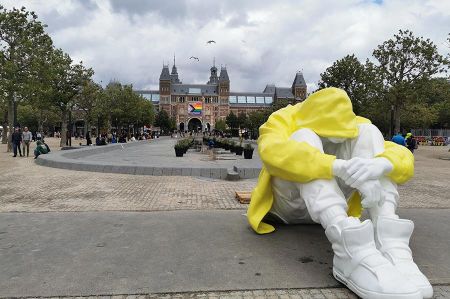 The modern building of the Van Gogh Museum is located next to the Moco Museum and the Concert-Gebouw in the Museumsplein not far from the Reichsmuseum, one could say within sight. This time, too, our route by bike only deviated slightly from the route we had already used; the cycle path network in and around Amsterdam is really great.
The modern building of the Van Gogh Museum is located next to the Moco Museum and the Concert-Gebouw in the Museumsplein not far from the Reichsmuseum, one could say within sight. This time, too, our route by bike only deviated slightly from the route we had already used; the cycle path network in and around Amsterdam is really great.
The Van Gogh Museum in Amsterdam houses the largest collection of Van Gogh paintings in the world. But other artists from this period are also exhibited here. The two building complexes in which the museum is housed are no less worth seeing than the paintings inside. The original building was based on a design by Gerrit Rietveld. After his death in 1964, the construction was continued by his partners J. van Dillen and J. van Tricht and was inaugurated after completion on June 2, 1973. The permanent collection is now housed in this building.
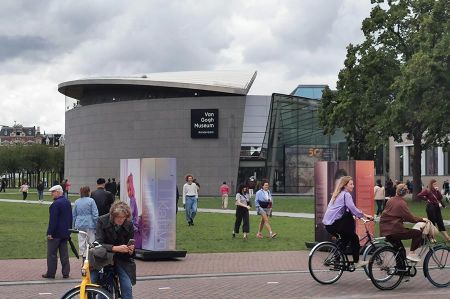 In 1999, an additional building for special exhibitions was inaugurated, designed by the Japanese architect Kishō Kurokawa in the shape of an ellipse. In 2015, the exhibition building was supplemented by a new, extensively glazed entrance area, the design of which also comes from the office of Kurokawa, who died in 2007. Both buildings are connected by an underground passage.
In 1999, an additional building for special exhibitions was inaugurated, designed by the Japanese architect Kishō Kurokawa in the shape of an ellipse. In 2015, the exhibition building was supplemented by a new, extensively glazed entrance area, the design of which also comes from the office of Kurokawa, who died in 2007. Both buildings are connected by an underground passage.
The museum has over 200 paintings by Vincent van Gogh from all creative periods and 400 of his drawings. The major works on display include The Potato Eaters, The Bedroom in Arles and just “one” version of the famous Sunflowers. The museum also houses the majority of Vincent van Gogh's letters.
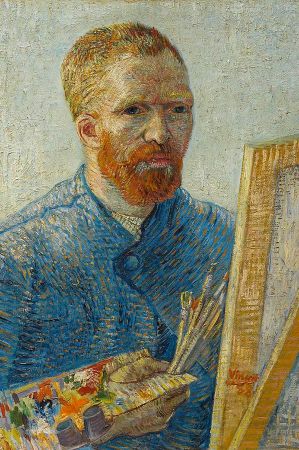 The collection also contains van Gogh's suicide weapon, a rusted Lefaucheux à broche. The collection started by Theo van Gogh with works by other 19th century artists was continually expanded with foundation funds, so that the museum now also includes works by Alma-Tadema, Bernard, Boulanger, Breton, Caillebotte, Courbet, Couture, Daubigny, Denis, Gauguin, Israëls, Jongkind, Manet, Mauve, Millet, Monet, Munch, Pissarro, Puvis de Chavannes, Redon, Seurat, Signac, Toulouse-Lautrec, van Dongen and von Stuck.
The collection also contains van Gogh's suicide weapon, a rusted Lefaucheux à broche. The collection started by Theo van Gogh with works by other 19th century artists was continually expanded with foundation funds, so that the museum now also includes works by Alma-Tadema, Bernard, Boulanger, Breton, Caillebotte, Courbet, Couture, Daubigny, Denis, Gauguin, Israëls, Jongkind, Manet, Mauve, Millet, Monet, Munch, Pissarro, Puvis de Chavannes, Redon, Seurat, Signac, Toulouse-Lautrec, van Dongen and von Stuck.
For most people, Van Gogh's most famous work is Sunflowers. He painted these flowers in countless versions - only one of which, as already mentioned, is in the Van Gogh Museum. But his dark work “The Potato Eaters” is also quite interesting. Van Gogh's self-portrait in front of his easel is also particularly well-known, showing a man who looks uncertain and suspicious. In the still life of his bedroom in Arles you can get an idea of how Vincent van Gogh lived.
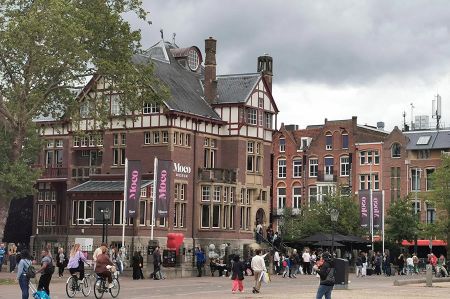 Van Gogh's works have an attractive effect. Perhaps this is due to the almost explosive emotionality of the images and the tragic story of his suicide at the age of just 37.
Van Gogh's works have an attractive effect. Perhaps this is due to the almost explosive emotionality of the images and the tragic story of his suicide at the age of just 37.
In addition to those well-known paintings, the van Gogh Museum also houses over 500 of the painter's drawings. Anyone who would like to delve even deeper into the personality of the painter Van Gogh can do so through the 700 letters on display.
By the way, the museum does not only contain works by Van Gogh, but also by some of his friends, painters of the same era. They include Toulouse-Lautrec, Claude Monet and Paul Gauguin.
Diagonally opposite – the Concert-Gebouw concert hall
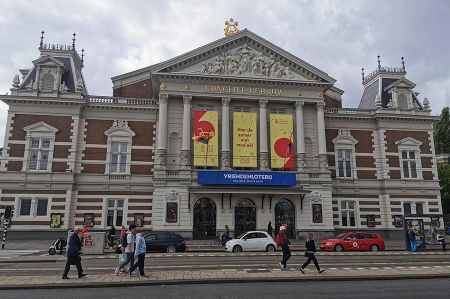 We had noticed several times the building that is also located on Museumplein, the so-called Concertgebouw. We were luckier here because it was possible to get an insight outside of the game time.
We had noticed several times the building that is also located on Museumplein, the so-called Concertgebouw. We were luckier here because it was possible to get an insight outside of the game time.
In 882 the building decision to build the concert hall was made in the Odeon theatre hall. Construction began in 1883 on property belonging to the municipality of Nieuwer-Amstel, which was then outside Amsterdam. It was not until 1896 that the district was incorporated into Amsterdam. The Concertgebouw opened on April 11, 1888 with 120 musicians, 500 choristers and works by Wagner, Handel, Bach and Beethoven. There are four halls. The Great Hall has 1,962 seats, the Small Hall, which was restored in 2004, has 437, and there is also the Choir Hall and the Hall of Mirrors. The building and orchestra were connected until 1952, but since then there have been separate organizations. For its 125th anniversary in 2013, Queen Beatrix awarded the Concertgebouw the title of Koninklijk ('Royal').
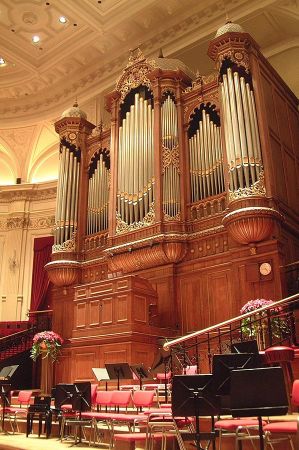 The architect Adolf Leonard van Gendt was inspired in his planning by the New Gewandhaus in Leipzig, which opened in 1884. Art Nouveau features can also be seen in the interior, including: in the chairs designed by Belgian architect Victor Horta.
The architect Adolf Leonard van Gendt was inspired in his planning by the New Gewandhaus in Leipzig, which opened in 1884. Art Nouveau features can also be seen in the interior, including: in the chairs designed by Belgian architect Victor Horta.
The Concertgebouw is also considered the most important venue for classical music in the Netherlands because of its very good acoustics (“shoebox principle”) and - alongside the Boston Symphony Hall, the Great Musikvereinssaal in Vienna, the Berlin Philharmonic, the Théâtre des Champs-Elysées in Paris and of course the Elbphilharmonie Hamburg – one of the best in the world.
The Great Hall is 44 m long and 27.5 m wide with a ceiling height of 17.50 m. It is particularly suitable for works of Romanticism and chamber music as well as for solo performances. At the front is the concert organ by organ builder Michaël Maarschalkerweerd.
Behind the Great Hall there is a smaller oval hall on the upper floor, the Small Hall. It is 20 m long and 15 m wide. It is a more intimate hall specifically for chamber music. All around are the Felix de Nobel foyer, the French foyer, the circulation (since 1988) and the vestibule. The music hall of Felix Meritis on the Kaisergracht, built a hundred years earlier, served as a model.
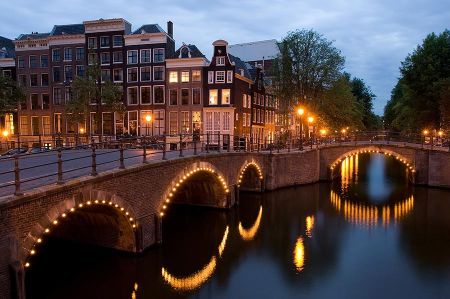 Behind the Great Hall, on the ground floor, directly below the Small Hall, is the so-called Hall of Mirrors with the same floor plan. Until 1925 there was access to the garden behind the concert building from here. After the garden land was sold to the city of Amsterdam, the view was no longer as beautiful and the window panes in the doors were replaced with mirrors. It has crystal chandeliers and columns to support the Small Hall. The Hall of Mirrors is used multifunctionally as a café and foyer as well as a reception room for special guests. Radio broadcasts also come from the Hall of Mirrors.
Behind the Great Hall, on the ground floor, directly below the Small Hall, is the so-called Hall of Mirrors with the same floor plan. Until 1925 there was access to the garden behind the concert building from here. After the garden land was sold to the city of Amsterdam, the view was no longer as beautiful and the window panes in the doors were replaced with mirrors. It has crystal chandeliers and columns to support the Small Hall. The Hall of Mirrors is used multifunctionally as a café and foyer as well as a reception room for special guests. Radio broadcasts also come from the Hall of Mirrors.
Since we were slowly getting a little hungry, we decided to end the day by going to a restaurant in the area around Museumsplein that can also be considered typical for Holland: Indonesian. We then had the opportunity to photograph the Concert-Gebouw at night. Then we rode our bikes back to the campsite.
Please read as well:
